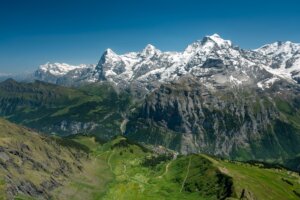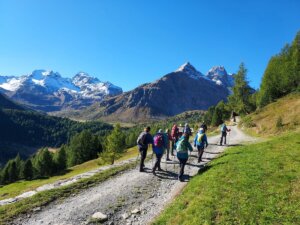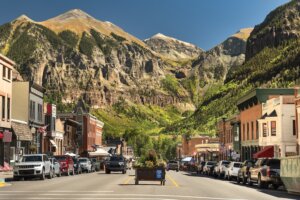The start of the New Year is a perfect time to start thinking about the various components that can either make or break a good hiking tour. Making sure that you have your passport in hand, choosing the appropriate travel insurance, beginning your athletic training and selecting the right equipment are just a few of the fundamentals. It’s no surprise then, that clothing is one of the topics that repeatedly rears it’s head during this exciting time of year. “Why can’t I wear cotton,” is one of the many questions that we field time and time again.
First of all, you CAN wear cotton, but it’s important to understand the strengths and limitations of cotton fabric (and other materials), in order to stay comfortable on the trail. (See my entry from May, 2007 titled “Choosing the Right Gear Part Three: Base layers and general hiking attire.”) In short, cotton is a comfortable material when it’s dry but it absorbs moisture like a sponge and holds it next to the skin creating significant heat loss. Cotton also takes a long time to dry thereby adding discomfort. Therefore, to avoid taking any chances, we don’t recommend wearing cotton when traveling through alpine environments where staying warm might be an issue.
Recently, a fellow colleague pointed me to the results of an experiment that illustrated the suitability of wool and cotton clothing for outdoor use. A gentleman named Steve Howard from the Los Alamos National Laboratory performed the experiment in order to show how cotton absorbs water and encourages heat loss compared with other materials. Mr. Howard presented his findings at a gathering of Search and Rescue teams in New Mexico.
Here’s a summary of his experiment.
Mr. Howard started with four, one-gallon jugs and filled each one of them with hot water at 114.5 degrees F. Then he wrapped one in a wool shirt, one in a similar thickness pile (synthetic fleece) shirt, one in a cotton flannel shirt and one he left “naked”. He then showered them with cold water in the shower for 5 minutes to simulate a rain storm and then turned a fan on them. He measured the temperature of each jug every five minutes for one hour.
If you look at the results below then you’ll see that after one hour, the gallon jug wrapped in a wet cotton shirt lost the most heat through evaporation-30 degrees in one hour! The jug wrapped in wool retained the most heat and lost just half of what the cotton jug lost. What about the naked jug? The “naked” jug retained more heat than the cotton-wrapped jug but the question still remains, “Is going naked better than wearing cotton?”
Well, for group motivational and entertainment purposes the answer is a resounding YES. However, physiologically the experiment isn’t exactly accurate because the “naked” jug can’t simulate the normal evaporative process of the skin. Even an inactive person usually sweats a little while sitting still. The pores of our skin constantly open and close to regulate our body temperature. Therefore, I submit that more testing might be in order. In general though, the experiment does put things into perspective and the take home point is this: Wrapping something in wet cotton fabric is a great way to keep it cold. This can be great in the desert but mountain environments are another matter. Imagine getting your shirt nice and wet from perspiration on a long climb and then standing in a chill wind at the top of a mountain pass. Brrrr. Wearing wet cotton clothing is essentially the same as wearing a swamp cooler, great in warm weather, bad in cold conditions.
This experiment also illustrates another key point. While synthetics are typically better than cotton for preventing heat loss, they’re still not perfect when they stand alone. The synthetic pile in this experiment lost 20 degrees by evaporation. The advantage of synthetics is that they typically work as a system with the body and wick moisture away from the skin. Cotton doesn’t wick. This is why layering with wicking materials is so important because it allows us to move the remaining moisture away from skin to the far outside layers where it can evaporate in peace without making us cold. In it’s defense, the pile in this experiment didn’t really have the opportunity to show it’s true capabilities.
Synthetic wicking layers also allow us to regulate our body temperature by adding and removing layers so that we don’t saturate our clothing in the first place. Add good quality rain gear on top of this and the other take home point becomes: Develop an entire clothing system that provides versatility. Don’t rely on one piece of clothing or gear to pull you through.
The following charts illustrate the results of Mr. Howard’s experiment. Enjoy.
| Time | Wool | Pile | Naked | Cotton |
|---|---|---|---|---|
| 0 min. | 114.5 | 114.5 | 114.5 | 114.5 |
| 5 min. | 111.8 | 110.3 | 108.4 | 109.2 |
| 10 min. | 110.2 | 108.4 | 106.0 | 106.2 |
| 15 min. | 109.1 | 106.6 | 104.0 | 103.5 |
| 20 min. | 107.8 | 104.9 | 101.9 | 100.3 |
| 25 min. | 106.7 | 103.5 | 99.9 | 97.4 |
| 30 min. | 105.7 | 101.7 | 97.9 | 94.9 |
| 35 min. | 104.6 | 100.3 | 96.1 | 92.7 |
| 40 min. | 103.5 | 98.6 | 94.5 | 90.5 |
| 45 min. | 102.4 | 97.2 | 93.1 | 88.9 |
| 50 min. | 101.3 | 95.8 | 91.6 | 87.2 |
| 55 min. | 100.3 | 94.5 | 90.4 | 85.6 |
| 60 min. | 99.4 | 93.1 | 89.1 | 84.4 |
Results courtesy of the Wilderness Emergency Medical Services Institute.





















Comments are closed.